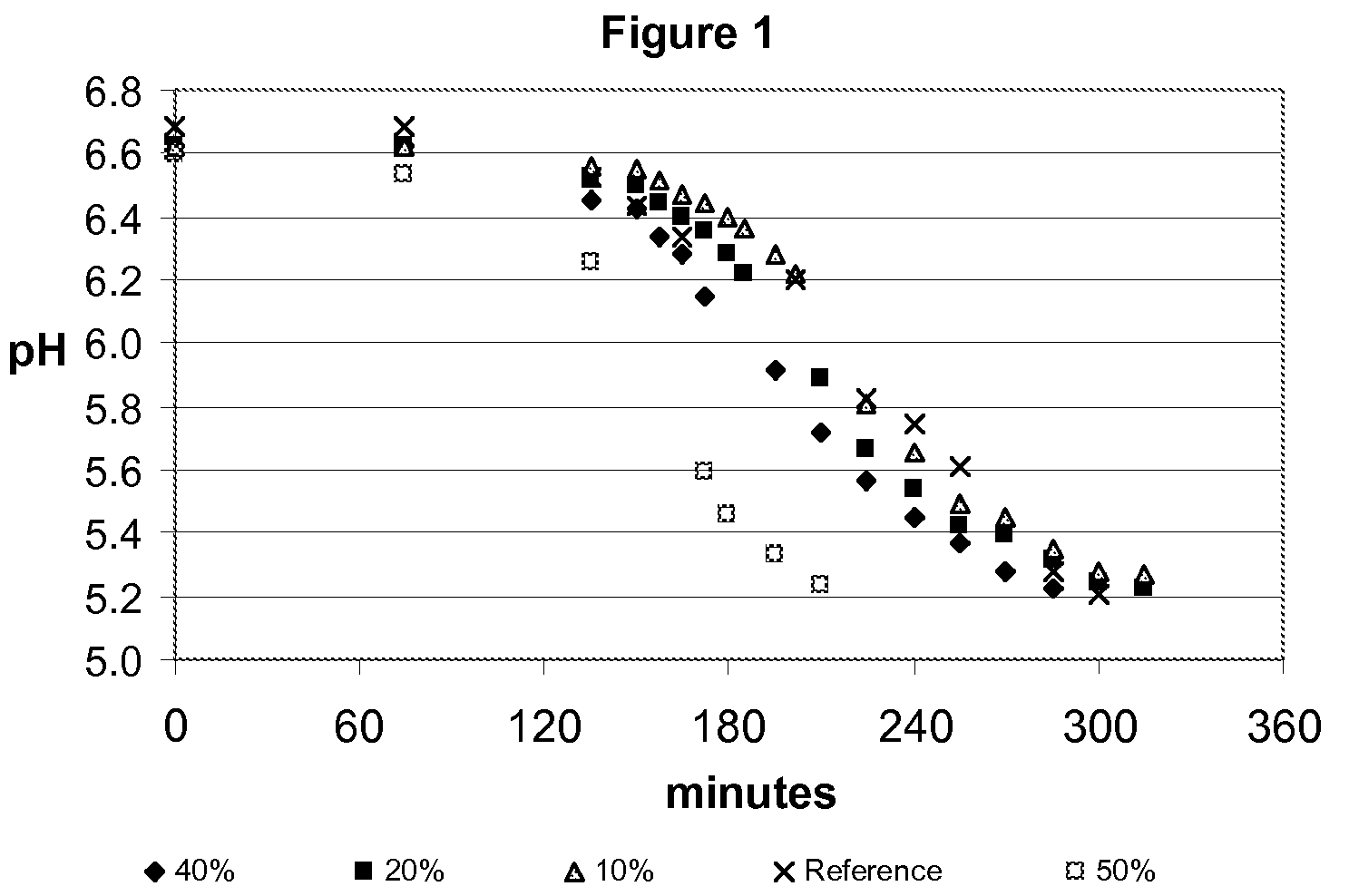Method for producing cheese
- Summary
- Abstract
- Description
- Claims
- Application Information
AI Technical Summary
Benefits of technology
Problems solved by technology
Method used
Image
Examples
example 1
Effect of Yeast Extracts on the Coagulation of High Heated Milk
[0054]Low heat skim milk was prepared by by dissolving 11 grams of milk powder (Nilac, NIZO food research) in 100 grams of distilled water while gently stirring. This milk was heated for 10 minutes at 80° C., and cooled to 31° C. Non-heated milk was used as a reference. Milk samples were transferred to a Formagraph. Yeast extract was added (10% on protein base: 10 gram whey protein hydrolysate per 100 g milk protein) and milk coagulation was started by the addition of coagulant (0.08 IMCU per ml, Maxiren from DSM). Clotting time r and curd strength (k20) were determined. Results for several hydrolysates are given in table 1.
TABLE 1Effect of various yeast extracts on milk clotting of high heated milk. All yeastextracts were obtained from DSM, The Netherlands)Yeast extractType of yeastrk20 SampleaddedBatch codeextract(in seconds)(in seconds)Non-heatednone——300780milkHigh heatednone——4803300milkHigh heatedMaxapureFSGHE 50Hy...
example 2
Preparation of Mozzarella at 1 Liter Scale
[0056]Mozzarella cheese was made on 1L scale as follows. 1 liter of pasteurized full fat cows milk was heated to 34° C. In some cases, mixtures of pasteurized and high heated milk were used, in which the volume percentage of high heated milk varied from 10%, 20%, 30%, 40%, 50% up to 100%. Next, 176 microliters Delvotec TS10 / L (starter culture, DSM, The Netherlands) were added and the milk was gently stirred for 1 hour at 34° C. After this hour, optionally, the yeast extract was added, followed by another 10 minutes of stirring. Coagulation was initiated by addition of 80 microliters Fromase 750 XLG (DSM, The Netherlands). After 45 minutes the curd was cut during 60 seconds and left for another 15 minutes. Then the temperature was raised to 41° C. under gentle stirring until the pH had dropped to pH6.2. Whey was separated from the curd, and the curd was double-folded on itself. The wet curd was turned every 15 minutes until the pH reached 5.2...
example 3
Effect of Yeast Extract on the Cheese Making Properties of Milk Containing High Heated Milk
[0057]Mozzarella was prepared at 1 L scale, using the protocol described in example 2. Milk was used that contained 30% high heated milk (80° C., 10 minutes) and 0.1% (w / v) Gistex LS (DSM, The Netherlands) were added. In the control experiment, only pasteurized milk was used and no yeast extract was added. Surprisingly, the milk containing the Gistex LS acidified very fast, leading to curd with poor knitting characteristics. The curd particles were much less cohesive compared to the regular situation, leading to fine curd particles which are not retained and therefore lead to yield losses. In order to circumvent this problem, the dosage of starter culture was reduced in steps to 50, 40, 20 and 10% of the original doses as given in Example 2. The acidification curves are given in FIG. 1, including a reference acidification curve under conditions as given in example 2 without Gistex LS. Clearly,...
PUM
 Login to View More
Login to View More Abstract
Description
Claims
Application Information
 Login to View More
Login to View More - R&D
- Intellectual Property
- Life Sciences
- Materials
- Tech Scout
- Unparalleled Data Quality
- Higher Quality Content
- 60% Fewer Hallucinations
Browse by: Latest US Patents, China's latest patents, Technical Efficacy Thesaurus, Application Domain, Technology Topic, Popular Technical Reports.
© 2025 PatSnap. All rights reserved.Legal|Privacy policy|Modern Slavery Act Transparency Statement|Sitemap|About US| Contact US: help@patsnap.com

